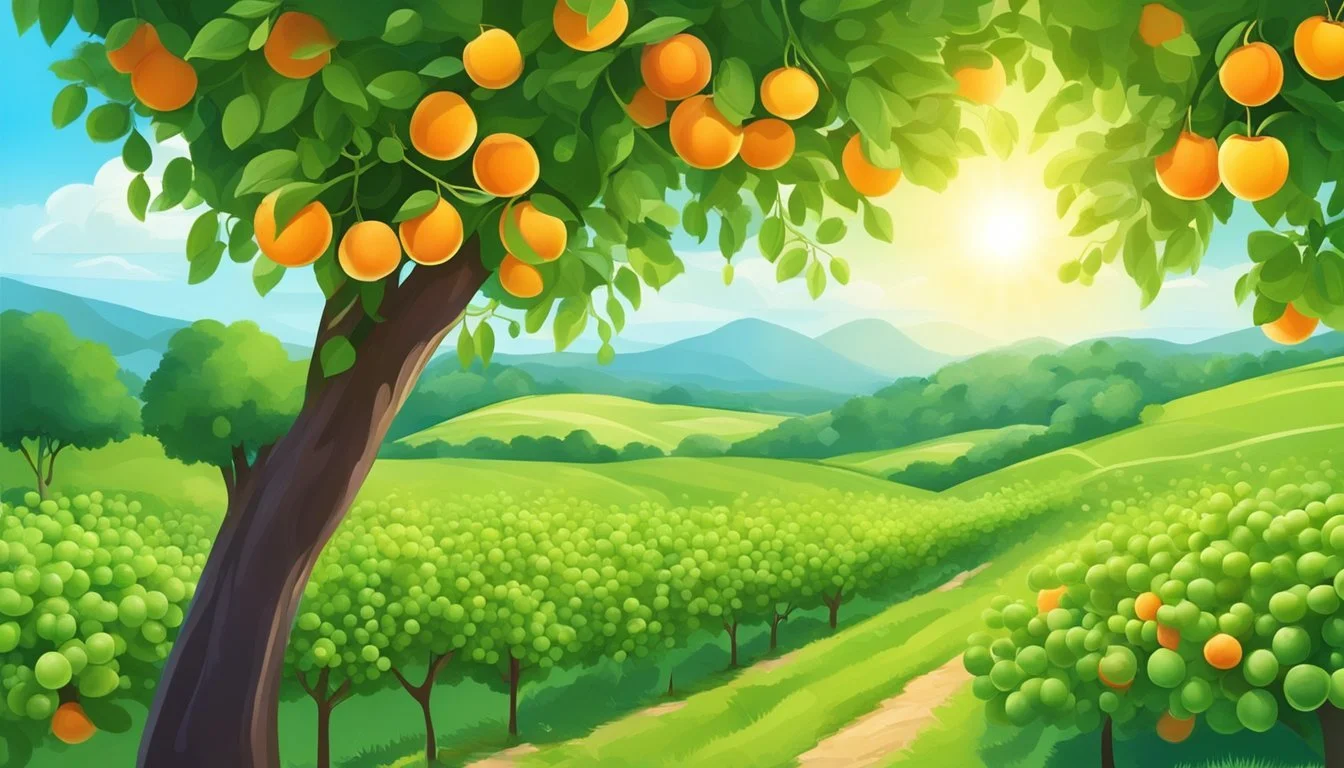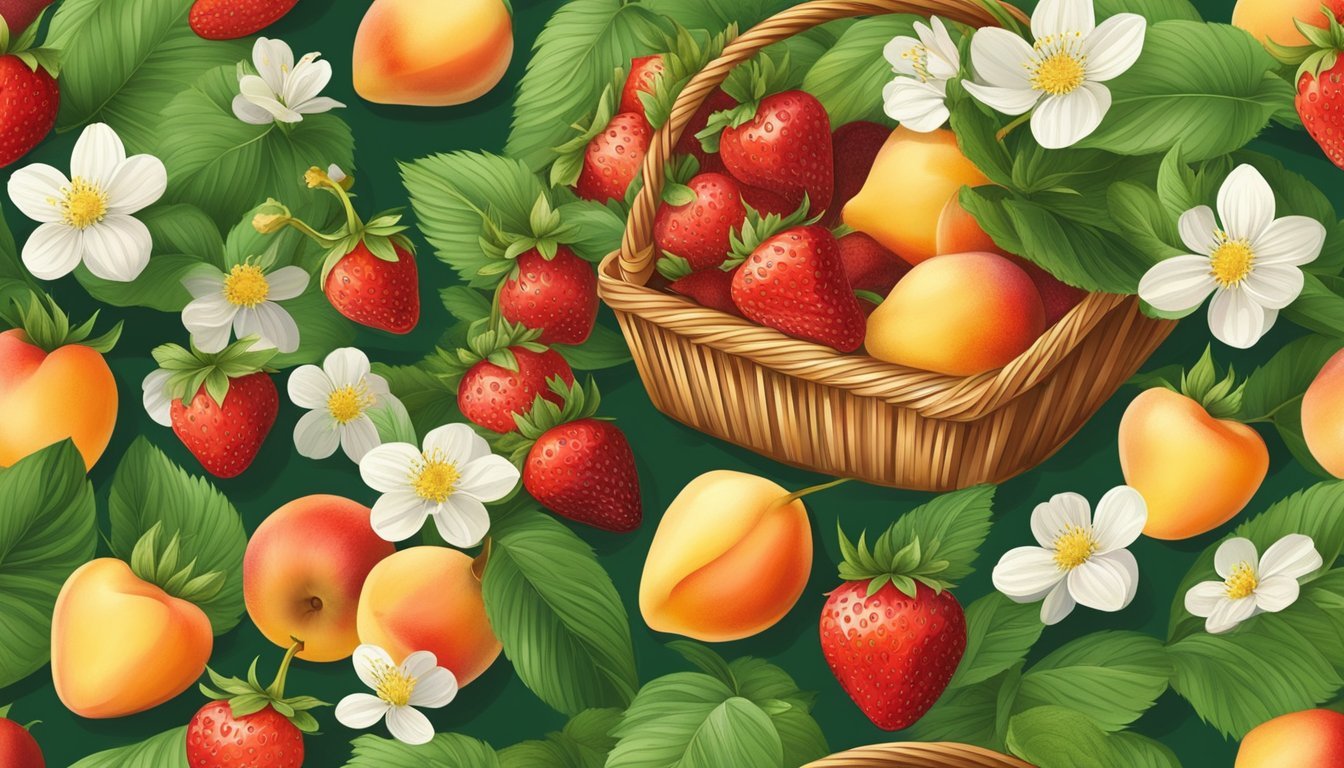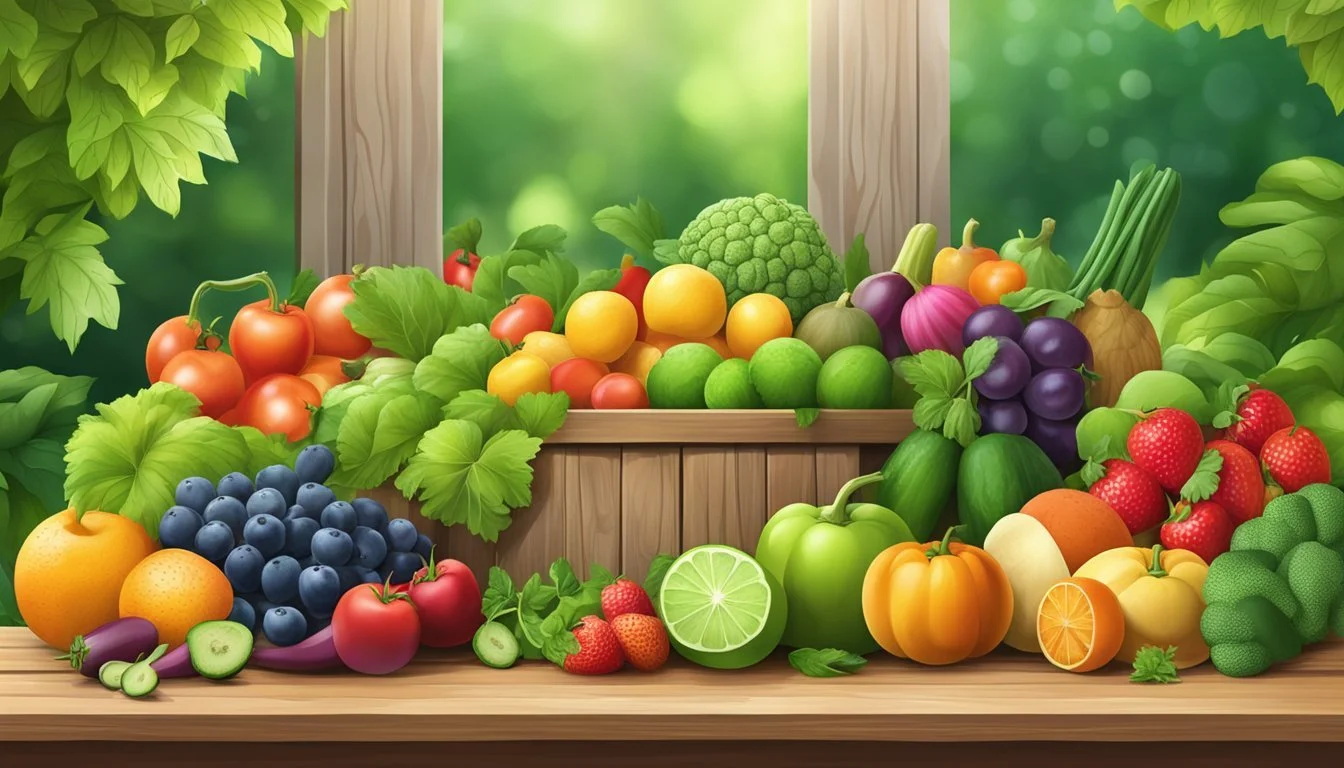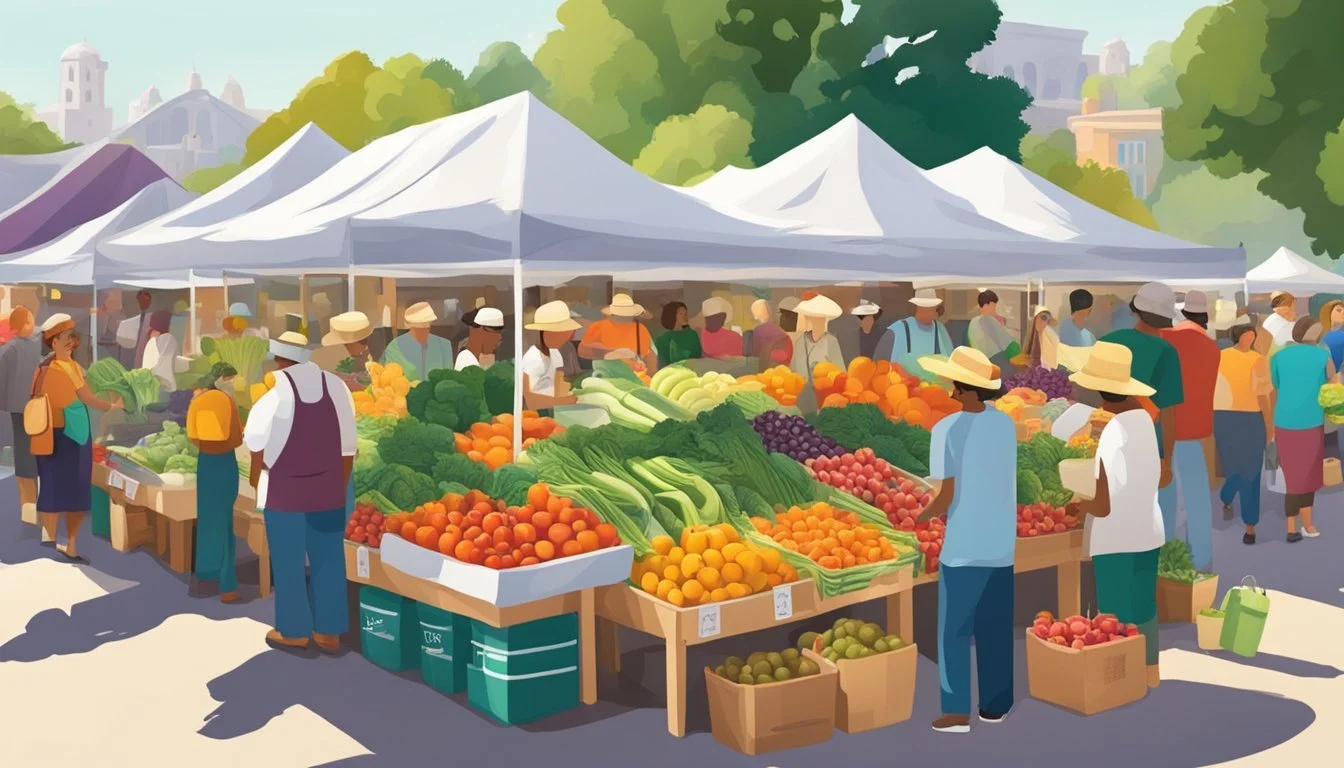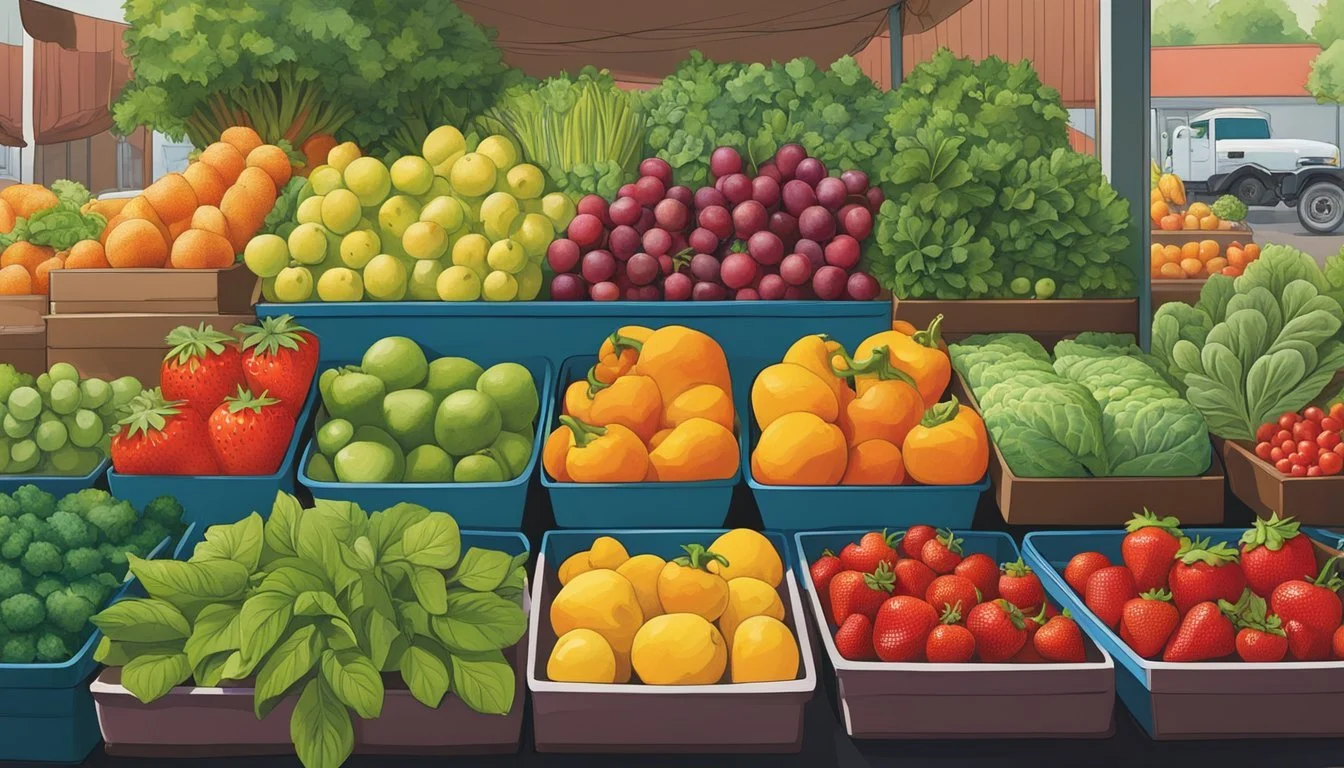Washington Seasonal Fruit & Vegetables in June
Your Guide to Fresh Produce
This Article is Part of our Washington Seasonal Fruit & Veg Calendar
Washington State greets the summer season with a bounty of fresh fruits and vegetables that reach their peak in June. This period marks a delightful time for consumers and chefs alike to savor the flavors of local produce, characterized by its freshness and quality. During this month, farmer's markets and grocery store produce aisles are brimming with vibrant offerings sourced from the region's fertile lands.
Among the fruits that take center stage are the juicy strawberries and cherries (how long do cherries last?), perfect for homemade pies or eaten fresh, signaling the true start of summer. Blueberries begin to make their appearance, hinting at the succession of berry varieties poised to ripen as the weeks progress. The stone fruits, such as apricots and peaches, also start to emerge, promising sweet and succulent flavors.
The vegetable selection is just as robust, with staples like broccoli (how long does broccoli last?)and carrots widely available, offering versatility for a range of dishes from raw salads to hearty cooked meals (how long do cooked meals last?). Leafy greens such as lettuces and spinach (What wine goes well with spinach?) retain their springtime glory, while beets and radishes provide a pop of color and earthy tastes to the season's palate. Washington State's June harvest showcases a snapshot of summer's abundance, providing a rich tapestry of flavors and nutrients.
Understanding Seasonality
This section will explore the value of consuming fruits and vegetables at their seasonal peak and provide a glimpse into what is fresh and in season during June in Washington.
Importance of Eating Seasonally
Eating seasonally is essential for a number of reasons. Primarily, it ensures that consumers are getting produce that's at its peak in both nutrients and flavor. Seasonal fruits and vegetables tend to be fresher, as they are often harvested locally and sold shortly after picking. This not only delivers superior taste but also supports the local economy and farmers. Additionally, seasonal produce often has a lower environmental footprint, as it requires fewer resources for growth and transportation when sourced locally.
June's Seasonal Calendar
In June, Washington showcases an abundance of seasonal produce with diverse flavors and nutritional profiles. Here’s a list of fruits and vegetables that are fresh and in season:
Fruits:
Cherries
Apricots
Vegetables:
Lettuce
Radishes
It's a prime month for enjoying these raw, fresh ingredients in a variety of dishes, from salads to desserts. Consumers can take advantage of the seasonal abundance for the freshest, tastiest, and most nutritious produce available.
Seasonal Fruits
In June, Washington's agricultural richness offers a vibrant bounty of fruits. The season is marked by the ripening of various berries and stone fruits, each with its own distinctive taste profile, from sweet to tart.
Berries and Stone Fruits
Strawberries: Often at their peak in June, they provide a sweet, yet slightly tart flavor.
Cherries: Sweet cherries become available and are known for their juicy and sweet profile.
Blueberries: These berries start to become ripe, offering a balance of sweet and tart tastes.
Apricots: Recognized for their sweet and slightly tart flavor, apricots are also enjoyed during this time.
Peaches: The beginning of peach season introduces a sweet and succulent option for fruit lovers.
Tropical and Exotic Varieties
Washington is not typically known for tropical fruit cultivation, but with modern agricultural advancements and importation, the following can be found:
Melon: Various melons can be found in markets, ranging from sweet cantaloupes (how long does cantaloupe last?) to refreshing honeydews.
Mango: Although not locally grown, mangos are often available and ripe, offering a sweet and tropical flavor to the mix of local Washington fruits.
Each fruit listed above can be enjoyed fresh and is widely used for both raw consumption and in various culinary preparations, enhancing the flavor profiles of dishes with their ripe, sweet, or tart notes.
Seasonal Vegetables
In June, Washington's agricultural richness blooms with a variety of vegetables. Consumers can find a bounty of leafy greens and herbs, alongside freshly harvested root vegetables and bulbs, as well as the first pickings of squashes and pods.
Leafy Greens and Herbs
June welcomes an abundance of leafy greens and herbs. This is the time when vegetables like lettuce, arugula, spinach, and kale reach their peak. These leafy veggies are both versatile and nutritious, making them ideal for fresh salads.
Lettuce: Ranging from crisp romaine to delicate butter lettuce.
Arugula: Known for its peppery flavor.
Spinach: Rich in iron and perfect for both cooking and raw dishes.
Kale: A hearty green that’s great in salads and smoothies.
Root Vegetables and Bulbs
The cool soil of the early summer yields a variety of root vegetables and bulbs. Garlic and onions are harvested and begin to feature prominently in cuisine, while radishes and carrots offer a crisp, fresh taste to the season's dishes.
Garlic: Aromatic and essential in many recipes.
Onions: Ranging from sweet to sharp.
Radishes: Offering a peppery bite, perfect for salads.
Carrots: Sweet and crunchy, ideal for snacking or adding to dishes.
Squashes and Pods
Squashes and pods signify the start of summer's abundance. Green beans, peas, and a variety of squash like zucchini provide a fresh, green palette to Washington's seasonal spread.
Green Beans: Tender and mildly flavored, excellent for sautéing or steaming.
Peas: Sweet and plump, enjoyed fresh from the pod or in cooking.
Zucchini: Mild and versatile, perfect for grilling or as a pasta substitute.
Farm to Table
June in Washington state showcases a bounty of local produce, ripe and ready for the farm-to-table movement. This movement emphasizes fresh, seasonal ingredients sourced directly from local farms to the consumers' tables, thereby supporting the community and reducing the carbon footprint associated with long-distance food transport.
Local Farming Practices
In Washington, June's local farming practices are geared towards sustainability and maximizing the quality of the harvest. Farms employ crop rotation, organic methods, and integrated pest management to ensure soil health and reduce the impact on the surrounding ecosystem. Local produce like cherries, strawberries, and various leafy greens are typically harvested during this month. These farms are pivotal in supplying farmers' markets, local restaurants, and grocers with produce that embodies the essence of the region’s fertile land.
Community Supported Agriculture (CSA)
Community Supported Agriculture (CSA) programs are a cornerstone of the farm-to-table concept. They directly connect consumers with local farms, creating a symbiotic relationship.
CSA Benefits Details Freshness Members receive seasonal produce at its peak freshness. Community Engagement CSAs foster a connection between the farm and community. Support for Local Economy Funds go directly to support the local agricultural economy.
Consumers commit to a season of produce from their local farms and receive regular deliveries of fresh, seasonal produce, including June's nutrient-rich bounty. The CSA model helps to ensure that farmers have a stable income and can plan their crop yields accordingly, while consumers benefit by receiving the freshest food available and supporting their state's agricultural framework.
Preparing Seasonal Foods
In June, Washington's bounty offers an abundance of fresh produce, perfect for a variety of cooking techniques and recipe ideas. One can enhance the natural flavors of these seasonal offerings through grilling, roasting, and incorporating them into refreshing salads and salsas.
Cooking Techniques
Grilling: Seasonal vegetables such as corn can be grilled to perfection. For seasoned grilled corn, one may brush it with butter and herbs before placing it on the grill, turning occasionally until tender and slightly charred.
Roasting: Roasting is ideal for amplifying the sweetness of vegetables. Simple roasted vegetables can be achieved by tossing them with olive oil, salt, and pepper, and then roasting in an oven at 425°F (220°C) until they are caramelized and tender.
Recipe Ideas
Salads: Cucumber salads offer cool, crisp refreshment. They can be prepared by slicing cucumbers and tossing them with a light vinaigrette, perhaps with a touch of dill for added flavor.
Salsa: Incorporating seasonal fruits into a salsa can add a sweet and spicy kick to dishes. A strawberry salsa can be created by mixing diced strawberries with jalapeño, lime juice, and cilantro.
Strawberry Pie: The classic strawberry pie is a delightful way to showcase fresh strawberries. The pie can be prepared with a flaky, buttery crust filled with glazed strawberries.
Each recipe idea utilizes the freshness of June's seasonal produce in Washington. By following these cooking techniques and recipe suggestions, one can create dishes that are full of flavor and representative of the season's harvest.
Health and Nutrition Benefits
Consuming fresh, raw produce offers an array of health and nutrition advantages. In Washington during June, the burst of seasonal fruits and vegetables equates to a feast of vitamins, minerals, and fiber, all essential for maintaining a healthy diet.
Berries: They lead the way in antioxidant content, contributing to the reduction of oxidative stress and inflammation in the body. Blueberries, strawberries, and raspberries, are particularly dense in vitamins C and K, alongside manganese.
Leafy Greens: Encompassing spinach, kale, and lettuce, the greens available are rich in vitamins A, C, E, and K. They're known for promoting heart health and supporting a strong immune system.
Summertime Squash: Varieties like zucchini provide notable amounts of vitamin B6, riboflavin, and manganese. It's a heart-healthy choice, recognized for its ability to help lower cholesterol levels.
Melons: Watermelon, in season, is a hydrating fruit comprised mostly of water, but also provides vitamins A and C. It's a refreshing choice that also delivers lycopene, an antioxidant.
Incorporating these seasonal options into meals ensures a high nutritional value intake while supporting local agriculture and ensuring the produce consumed is at its peak of freshness and flavor.
Produce Key Nutrients Berries Antioxidants, Vitamins C, K, Manganese Leafy Greens Vitamins A, C, E, K Summer Squash Vitamin B6, Riboflavin, Manganese Melons Vitamins A, C, Lycopene
Eating an assortment of fresh fruits and vegetables in season not only enhances the diversity of one's diet but also optimizes the health benefits derived from each unique produce item.
Food Preservation
Preserving the bounty of Washington's seasonal fruits and vegetables in June ensures they can be enjoyed year-round. Canning, pickling, freezing, and drying are all effective methods to extend the shelf life of fresh produce while retaining nutritional value and flavor.
Canning and Pickling
Canning is a reliable way to store fruits and vegetables at their peak freshness. They must be processed in a water bath or pressure canner to destroy microorganisms and create a vacuum seal. Commonly canned items in June include berries and cherries.
Pickling is another preservation method where produce is submerged in a brine or vinegar solution. Washington's cucumbers can be turned into pickles, and beets are also excellent for pickling.
Freezing and Drying
Freezing is perhaps the simplest preservation method. Vegetables like broccoli and snap peas should be blanched before freezing to maintain texture and flavor. Fruits such as berries can be frozen on a tray before transferring to containers to prevent clumping.
Drying, whether by air, oven, or dehydrator, concentrates the flavor and extends the storage life of fruits and vegetables. Herbs, cherries, and berries are good candidates in June for this method. With drying, it is critical to ensure the produce is thoroughly dehydrated to prevent mold growth.
Impact on Local Economy
In Washington State, the purchase of local produce has a significant effect on the local economy, particularly during peak harvest months like June. This economic influence is multi-dimensional, benefiting various aspects of the state's financial well-being.
Farmers Markets, a hub for seasonal transactions, both boost the circulation of money within the community and provide direct sales avenues for farmers. By supporting these markets, consumers ensure that a larger share of their expenditure stays local. The direct transaction between consumer and grower bypasses intermediaries, optimizing the farmer's share of the profit.
Local farmers who participate in the cultivation and sale of seasonal fruits and vegetables, such as cherries and green beans in June, stand to benefit from the heightened demand. Here is a brief list of popular produce available in Washington during the month of June:
Fruits: Cherries, Strawberries
Vegetables: Green Beans, Peas, Leafy Greens (such as Spinach and Lettuce)
Purchasing locally grown items not only sustains individual farm operations but also contributes to the preservation of farming as a viable livelihood in the state. The ripple effect of these transactions can be observed in the proliferation of ancillary businesses, such as local seed suppliers and agricultural equipment sellers, which also thrive as the local agricultural sector grows.
The economic impact of buying local is reinforced by the fact that local producers are more likely to reinvest their earnings into the local economy, magnifying the positive financial implications for Washington State. This form of cyclical investment is vital for the robustness and resilience of the local economy, ensuring financial capital remains within community borders.
Seasonal Eating Challenges
In Washington state, June presents specific challenges for consumers trying to eat seasonally. These challenges primarily relate to the availability of produce and the impacts of local weather and climate conditions.
Availability and Access
Consumers may find that even within a state rich in agricultural diversity like Washington, availability of certain fruits and vegetables can be inconsistent. Farm-to-market supply chains can be disrupted by a variety of factors—an issue which may leave shelves sporadically empty of local favorites.
Local Markets vs. Supermarkets: Some items may be abundant in local farmers markets but not as readily available in larger supermarkets.
Distribution Limitations: Limited distribution networks can affect how quickly and efficiently produce reaches consumers.
Economic Barriers: Costs associated with locally grown, seasonal produce may be prohibitive for some, influencing access and availability.
Weather and Climate Factors
Weather and climate play significant roles in the growth cycles and harvesting periods of crops, directly impacting what’s available each month.
Variable Climate: Washington's diverse climate—from coastal regions to eastern plains—results in a broad range of growing conditions.
Late Frosts or Heatwaves: Unpredictable weather events such as late frosts or early heatwaves can delay or damage crops, respectively.
Microclimate Impacts: Microclimates within the state can mean that while one area is bounteous, another nearby locale may have poor yields.
Washingtonians who seek a diet consisting solely of locally-sourced, seasonal produce must navigate these geographic and socioeconomic challenges in June and throughout the year.
Conclusion
Washington's diverse climate and fertile soil contribute to a bountiful harvest of seasonal produce during the month of June. Consumers can savor a variety of fresh fruits and vegetables that not only offer culinary diversity but also promote sustainable eating habits. June is the opportune time to enjoy the vibrant flavors of these locally grown offerings.
A selection of the fruits and vegetables available in June include:
Fruits: Blueberries, Strawberries
Vegetables: Broccoli, Cabbage, Carrots, Cauliflower
It is prudent for consumers to capitalize on the abundance of June's produce to support local farmers and reduce environmental impacts. The practice of consuming seasonal and local produce ensures a lower carbon footprint and fosters a more sustainable food system.
The provided table highlights produce that are in season in Washington during June:
Fruits Availability Blueberries June - September Strawberries June
Vegetables Availability Broccoli June - September Cabbage June - February Carrots June - January Cauliflower June - September
Patrons are encouraged to visit local farmers' markets or participate in community-supported agriculture (CSA) programs to obtain the freshest seasonal produce. Doing so not only enriches the culinary experience but also bolsters Washington's agricultural economy.


